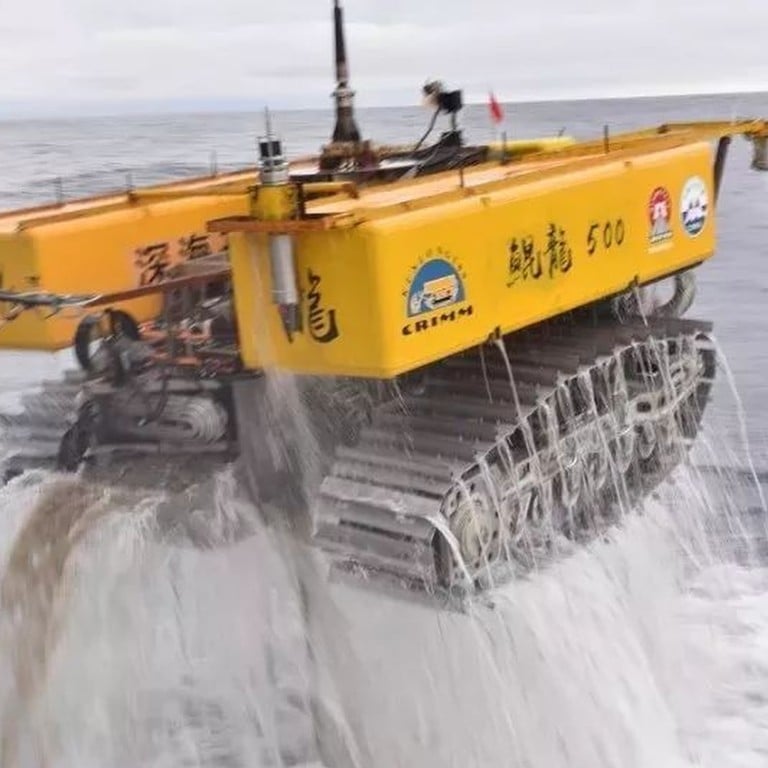
Chinese researchers aim to make a small splash for robots sent to mine the bottom of the ocean
- Robots are perfecting their diving skills in preparation for the serious business of tapping into mineral resources in the seabed
- One environmental protocol China proposes requires underwater drones to monitor mining robots and ensure no undersea environmental damage
An increasing number of Chinese deep-sea mining robots have been dropped into the world’s ocean in recent years. As the test-run hours grew, scientists and engineers discovered issues that, if not resolved properly, could affect these machines’ long-term operation.
A typical deep-sea mining robot is about the shape and size of a bulldozer and built to withstand the enormous pressure on the sea floor, which is sometimes thousands of metres deep.
When the machine enters the water, a huge splash cannot be avoided.
“A splash looks harmless. But it can release an enormous amount of energy in a split second. There are many mechanical parts, electronic devices and tethering components in an autonomous mining machine.
“They may not always survive the shock, especially in bad weather or after repeated use. We need to bring the impact under control,” said Dai Yu, professor of mechanical and electrical engineering with Central South University in Changsha.
Computer simulations and laboratory experiments conducted by Dai’s team suggested the splashdown of a mining robot had a physical process like no other. To avoid damaging it, tactics should include a speed limit of about 2 metres (6.56 feet) per second, when entering the water.
“This is not an easy exercise because in high seas, there are a lot of uncertainties,” said Dai, who is involved in the nation’s deep-sea mining programme. He and his colleagues published their findings in the Chinese Journal of Non-Ferrous Metals on Monday.
Could the world’s deep seas become China’s mining frontier?
China is the world’s biggest consumer of minerals, and its domestic ore supply falls far short of factories’ demand.
As a result, the Chinese government invested heavily in the development of deep-sea mining technology. Mineral resources in sea beds remain untapped and are mostly in areas that do not belong to any nation.
Some early versions of the Chinese mining robots even struggled in a lake. Now many of them can operate in the South China Sea, which has an average depth of 1,200 metres.
Some most advanced models, such as the Kunlong 500, were designed to operate at a maximum depth of 6,000 metres. In one hour the machine could locate, break apart and gather 10 tonnes of ore that would be sucked into a surface ship through a pipeline.
A deep sea mine does not need costly infrastructure such as roads, power lines or buildings, but the robots must operate reliably for a long period without human intervention.
There have been many studies on the physics of a splash but most only involved an object with a relatively simple structure, such as an airdropped torpedo or an unmanned submarine that can skip on the surface like a flying fish.
Dai and colleagues found these models could not solve the problem.
With complex structures – including a strong, flexible mechanical arm carrying various tools – the splash created by a deep sea mining robot was akin to that of humans. But unlike a free-fall diver, the robot was lowered by a rope and the swing caused by wind and waves added uncertainty to its motion, according to the researchers.
It could sometimes hit the ocean surface with a relative speed of 4 metres per second, if not faster, generating a splash too big for the machine to endure, according to the new study. At about half that speed, the robot can strike a balance between safety and efficiency.
Chinese scientists drill in contested South China Sea amid rising tensions
The researchers also discovered that the area taking the first and biggest shock was not the bottom of the robot, as generally believed, but the lower tip of the mechanical arm and its nearby body structure.
This knowledge would help operators reduce the imbalance caused by impact.
“The Ministry of Science and Technology has been quite generous in funding deep-sea mining research. This allows us to work on some detailed issues that no other countries have paid attention to, and get better prepared for the real business to come,” Dai said.
Experimental digging for deep-sea mining has been conducted by some Western countries, including the United States, as early as the 1950s.
Most of these efforts did not end well. Nautilus minerals, a Canadian company leading the development of underwater mining technology in the West, went bankrupt last year.
The biggest challenge is the environment — affecting an ecological system that humans still know little about.
In an advisory report to China’s central government earlier this year, Professor Wang Pingxian, a senior marine geologist in Shanghai, said China had secured a leading position in deep-sea research and technology in recent years, but the government must learn a lesson from Western countries to “avoid falling into a trap”.
Some countries, including the US and Japan, had underestimated the technical, environmental and political challenges of deep-sea mining and paid a heavy price for their mistakes, according to Wang.
“Ocean development is not as simple as a ‘gold rush’ … China has an urgent need to pull together different sources at home and abroad to lead an international effort,” he said in the report.
Though China still relies on foreign supplie for some components, it has achieved a series of breakthroughs on deep-sea mining hardware, including on hydraulic pumps for extreme environments, artificial intelligence for robotic control, communication and positioning technology for deep waters.
Chinese research ship heads to South China Sea on maiden voyage

